
|

|
Viking Age Arms and Armor
Other Viking Weapons
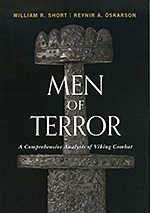 |
Much of the text presented on this page is out-of-date. Until we find time to make the needed updates to this page, we strongly encourage readers to look at this topic as it is presented in our new book, Men of Terror, available now from your favorite book seller. |
Other weapons are mentioned in the sagas and other sources. In general, we don't know what they were, and the old Icelandic words are translated differently by different sources. Examples from the period are not known to exist (although one wonders if there is an unrecognized lump of rusty iron on some museum's shelf that was once one of these weapons).
 |
The atgeirr was Gunnar Hámundarson's preferred weapon in Brennu-Njáls saga and is usually translated as "halberd" (although sometimes as "bill" or "javelin"). In addition to using it as a weapon, Gunnar routinely vaulted onto the back of his horse using his atgeirr. The saga text suggests that the weapon could be used both for thrusting and cutting. From the way Gunnar uses his atgeirr in the saga, one wonders if it might have been like a glaive, a pole weapon used in the later middle ages. Three 16th century glaives are shown in the photo to the left. |
|
In several battles, Gunnar thrust his atgeirr through his opponent, lifting him off his feet, and then hurling the body away (right). |
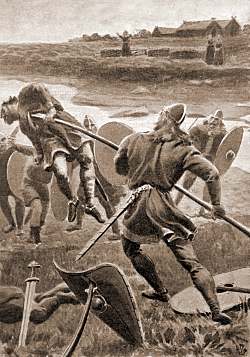 |
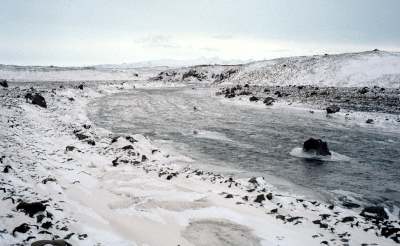 |
In the ambush at Rangá told in chapter 72 of Brennu-Njáls saga, Gunnarr thrust through Ţorgeirr Otkelsson, then threw his body into the Rangá river, where it drifted until it caught against a boulder in the water. The river at the battle site is shown to the left as it appears today. Gunnar's atgeirr is thought to lie at the bottom of Breiđafjörđur off the point of land called Skor (right), lost in a shipwreck in the 18th century. |
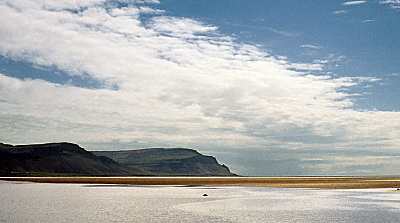 |
Egill used a kesja on several occasions (such as in chapter 58 of Egils saga), translated as "halberd". In chapter 2 of Gisla saga, Gisli used a höggspjót, also translated as "halberd". The word bryntröll (mail troll) is also used, translated as "halberd". In chapter 37 of Laxdćla saga, Hrútr struck Eldgrímr between the shoulders with a bryntröll, splitting his mail and cutting through Eldgrím's body.
One source suggests that atgeirr, kesja, and höggspjót all refer to the same weapon. A more careful reading of the saga texts does not support this idea. The saga text suggests similarities between atgeirr and kesja, which are primarily used for thrusting, and between höggspjót and bryntröll, which were primarily used for cutting. Whatever the weapons might have been, they seem to have been more effective, and used with greater power, than a more typical axe or spear. Perhaps this impression is because these weapons were typically wielded by saga heros, such as Gunnar and Egill. Yet Hrútr, who used a bryntröll so effectively in Laxdćla saga, was an 80-year-old man and was thought not to present any real threat.
Perhaps examples of these weapons do survive in archaeological finds, but the features that distinguished them to the eyes of a Viking are not so distinctive that we in the modern era would classify them as different weapons.
A careful reading of how the atgeir is used in the sagas gives us a rough idea of the size and shape of the head necessary to perform the moves described. This size and shape corresponds to some artifacts found in the archaeological record that are usually categorized as spears. The saga text also gives us clues about the length of the shaft. This information has allowed us to make a speculative reproduction of an atgeir, which we have used in our Viking combat training (right). Although speculative, this work suggests that the atgeir truly is special, the king of weapons, both for range and for attacking possibilities, performing above all other weapons. The long reach of the atgeir held by the fighter on the left can be clearly seen, compared to the sword and one-hand axe in the fighter on the right. |
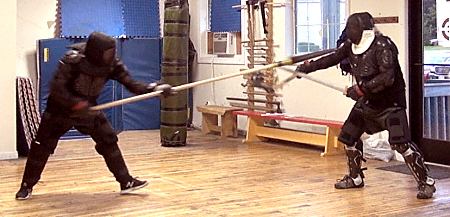 |
In chapter 66 of Grettis saga, a giant used a fleinn against Grettir, usually translated as "pike". The weapon is also called a heftisax, a word not otherwise known in the saga literature. The saga says that the weapon had a wooden shaft and was equally suited for striking or stabbing.
In chapter 30 of Harđar saga og Hólmverja, Hörđur threw a gaflak (javelin) at a man, killing him. In chapter 53 of Egils saga is a detailed description of a brynţvari (mail scraper), usually translated as "halberd". It had a rectangular blade two ells (1m) long, but the wooden shaft measured only a hand's length.
So little is known of the brynklungr (mail bramble) that it is usually translated merely as "weapon". Similarly, sviđa is sometimes translated as "sword" and sometimes as "halberd". In chapter 58 of Eyrbyggja saga, Ţórir threw his sviđa at Óspakr, hitting him in the leg. Óspakr pulled the weapon out of the wound and threw it back, killing another man.
 |
Rocks were often used as missiles in a fight. These effective and readily available weapons discouraged one's opponents from closing the distance to fight with conventional weapons, and they could be lethal weapons in their own right. Prior to the battle described in chapter 44 of Eyrbyggja saga, Steinţórr chose to retreat to the rockslide on the hill at Geirvör (left), where his men would have a ready supply of stones to throw down at Snorri gođi and his men. |
Búi Andríđsson never carried a weapon other than his sling, which he tied around himself. He used the sling with lethal results on many occasions. Búi was ambushed by Helgi and Vakr and ten other men on the hill called Orrustuhóll (battle hill, the smaller hill in the foreground in the photo), as described in chapter 11 of Kjalnesinga saga. By the time Búi's supply of stones ran out, he had killed four of his ambushers. A speculative reconstruction of using stones as missiles in battle is shown in this Viking combat demonstration video, part of a longer fight. |
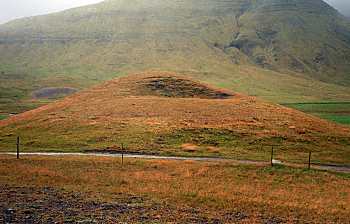 |
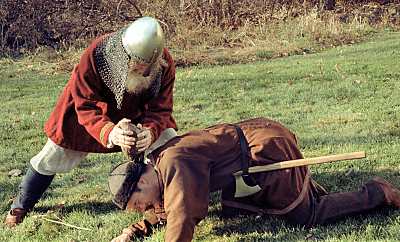 |
Rocks were used during a fight to finish an opponent, or to take the fight out of him so he could be killed with conventional weapons. After Ţorsteinn wounded Finnbogi with his sword, as is told in Finnboga saga ramma (ch. 27) Finnbogi struck Ţorsteinn with a stone. Ţorsteinn fell down unconscious, allowing Finnbogi to cut off his head. |
Some sources suggest that Vikings used machines to hurl their missiles. For example, when writing about the Viking sieges of Paris, Abbo Cernuus, a monk and an eyewitness to the events, wrote that the Danish invaders used siege engines and ballistae to hurl poisoned darts, javelins, and stones. I, like some other students of the period, remain highly skeptical of the use of these kind of machines by Vikings. There are many reasons to discount the writings of Abbo and other clerics who may have used familiar Latin words to describe unfamiliar Viking weapons and tactics.
Some 20th century scholars have suggested that most large Viking war ships were equipped with catapults. They estimate the machines were capable of throwing stones 3-10kg (about 5-20lbs) a distance of 300 m (about 0.2 miles). Again, I remain skeptical. Large Viking warships have been found, but archaeological evidence for these kind of machines is absent. Nor is there any discussion of their use in the saga literature, despite some detailed description of naval battles, notably in the kings' sagas. During the battles, rocks were thrown, arrows fired, and spears and other missiles hurled, but nothing in the literature suggests that any mechanism was used to send them on their way.
An exception is the throwing strings (snćrisspjót) used to launch spears, described in the article on spears.
Additionally, Eiríks saga rauđa (chapter 11) says that the skrćlingjar, the native Americans in Vínland, used valslöngur to unleash a barrage of unspecified missiles on the Greenlanders. The word is often translated as "catapult", but more likely refers to a hand-sling, a weapon known from other sources to have been used by native Americans.
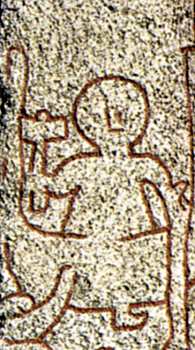 |
Some modern fantasy sources suggest that Vikings used war hammers in battle, perhaps inspired by Ţór's hammer, Mjöllnir. Evidence for the use of hammers as weapons in the Viking age is negligible. Even Ţór's hammer, often used to crush the skulls of giants, is described in poetry and shown in contemporary pictorial sources to be more like a blacksmith's hammer, not particular well-suited for combat. An 11th century picture stone (left) illustrates the story of Ţórr fishing for the Miðgarð serpent, with his foot through the bottom of the boat, and his hammer raised high. |
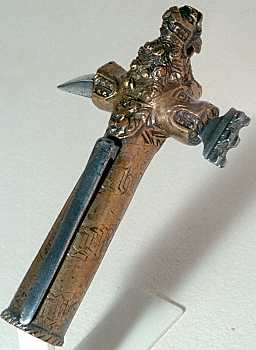 |
In the later medieval era, well after the end of the Viking age, armored knights used war hammers. The head of a 15th century war hammer is shown to the left. These weapons were optimized for damaging the joints of plate armor, reducing the mobility of an opponent, and making it easier to get past his plate armor defenses. The photo to the right shows the knight on the left using a war hammer for an overhead parry. |
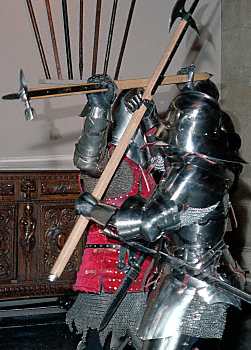 |
To be struck with something other than a weapon was an insult and a humiliation in Viking society. The shame was magnified if the blow also caused some other form of disgrace, such as soiling the clothes. In chapter 28 of Grettis saga, Auđun flung a skin sack filled with curds at Grettir, striking him and covering him with curds. Grettir considered it a greater insult than if Auđun had given him a bloody wound.
In chapter 32 of Finnboga saga ramma, Svartur, a herdsman, was armed only with a manure rake. As Jökull thrust with his spear, Svartur broke the spearshaft with his rake. Svartur threatened to land the second blow on Jökull's ear, which would have caused the greatest possible shame to Jökull.
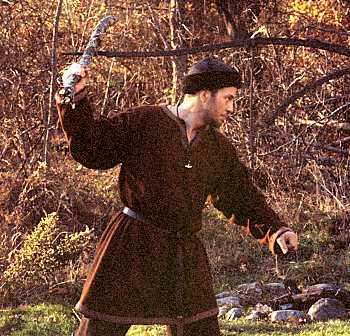 |
Regardless, many everyday items were placed into service as weapons, according to the sagas. Such items as a boathook (Hávarđar saga Ísfirđing chapter 4), a whale bone (Hávarđar saga Ísfirđing chapter 10), a scythe (Finnboga saga ramma chapter 40), a clothes beater (Reykdćla saga og Víga-Skútu chapter 22), a boat oar (Víga-Glúms saga chapter 27), an anvil (Óláfs saga Tryggvasonar chapter 41), mane shears (used for trimming a horse's mane, Bjarnar saga Hítdćlakappa chapter 32), and a sled runner (Eyrbyggja saga chapter 37) were used in fights, sometimes with lethal results. Clearly, fighting men used whatever was available to achieve their goal in a fight, even picking up sticks and using them as clubs. |
|
|
<< Previous article |
Back to Arms and Armor |
|
©1999-2025 William R. Short |